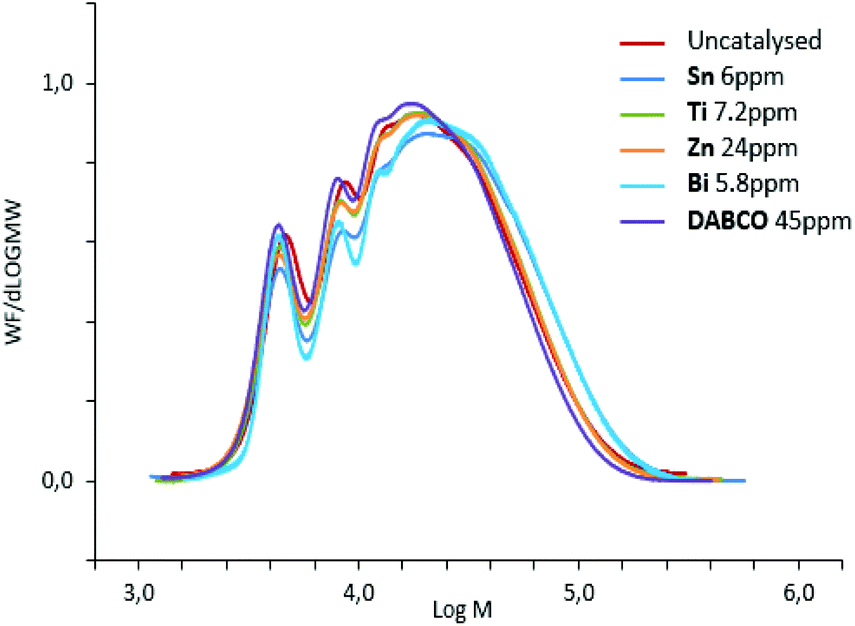To accelerate the reaction it is possible with advantage to use catalysts which are known within urethane chemistry such as Sn Bi Zn and other metal carboxylates tertiary amines such as for example 14-diazabicyclo222octane DABCO triethylamine etc. Dibutyltin dilaurate DBTDL can be considered the workhorse catalyst for urethane coatings.

Pdf Identifying Competitive Tin Or Metal Free Catalyst Combinations To Tailor Polyurethane Prepolymer And Network Properties
Metal Catalysts for Polyurethanes Tin Catalyst Tin-based catalysts are widely used in the industry as general purpose fast ac ng catalysts.

Tin catalyst polyurethane. Compared to that when catalyst was added to the mixture of diol and TDI. Our flagship catalyst series are the tin-free and non-toxic metal catalysts which are. Tin-free catalyst for one- and two-component polyurethane coatings Description Borchi Kat 22 is a tin-free catalyst based on metal carboxylate.
Figure 37 Proposed mechanism of bismuth carboxylate urethane catalysis. Tin is coming under intense scrutiny in Europe over its toxicity. Your TRiiSO Technical Sales Representative is available to assist you in the selection of the appropriate chemical that will provide the specific properties you are trying to obtain.
Cat Catalyst Pcat Product of Tin Catalyst and Polymer cat5 Pentamethyldiethylenetriamine PMDETA cat8 Dimethylcyclohexylamine DMCHA K Equilibrium Constant H Heat of Reaction MF Methyl Formate OF Objective Function MDI Methylene Diphenyl Diisocyanate TDI Toluene Diisocyanates HDI Hexamethylene-16-diisocyanate PMDI Polymeric MDI. The thermodynamics of this transformation has been evaluated and NMR data based on significant downfield OH proton shifts and line broadening in the presence of bismuth carboxylate catalysts. The kinetics of urethane fOimation reaction between isocyanate and.
Tin Catalysts Cata-Chek and Tinstab tin catalysts are a chemical intermediate used in the production of polyurethane and silicone formulations. Tosohs catalysts are efficient as well as reliable for polyurethane foam formation. Tin compounds have served the industry well.
Examples of simple organic esters include plasticizers lubricants and heat-transfer fluids. POLYURETHANE CATALYSTS Environmental and regulatory considerations are redefining the approach to urethane catalysis. On the formation of the alkoxide form of the catalyst.
In this paper we present evidence which strongly suggests that for the two catalysts DBTDL and DBTDB the catalytic cycle for urethane formation is that shown in Scheme 2. Borchi Kat 22 contains no organic complexing agents. Consequently there is renewed interest in metal carboxylate catalysts that could replace tin catalysts such as dibutyltin dilaurate in polyurethane formulations.
Niax catalyst A-133 is a low-concentration bis2-dimethylaminoethyl ether which is one of the most active polyurethane foam amine catalysts known. The cycle involves N-coordination of the isocyanate with the tin alkoxide 6 formed by alcoholysis of the starting tin compound 1 as shown in Scheme 1 to give the complex 7. Polyesters produced by the use of organotin compounds are used as binders for formulating coatings.
TIN CATALYSTS TIN-FREE CATALYSTS Solvent based Water based 2k Urethane curing. Triethylenediamine 14-Diazabicyclo 222octane cas no. The reaction is preferably carried out in the absence of water.
Typical metal carboxylates are based on. PATcat 3001 DBTL and PATcat 3003 DBTDA are very versa le catalysts. Non-Toxic Used In Cosmetics And.
TRiiSO distributes polyurethane catalysts based on tin carboxylates amines bismuth carboxylates zinc carboxylates zirconium carboxylates and nickel carboxylates. Require catalysts that demonstrate a degree of hydroly c stability. It is efficient eg a very low level of catalyst will greatly increase the NCOOH reaction rate.
Stannous Octoate Tin CatalystA clear to straw colored viscous liquid Stannous Octoate is used as a gelling catalyst in the manufacture of polyurethane foamPURPOSEIn the manufacture of polyurethane foam the gelation reaction between the polyol and isocyanate is catalyzed through the use of organometallic catalysts primarily Tin. Triethylenediamine CAS Number 280-57-9 is a white solid crystalline. Read more Lupragen N400.
Solvent evapora on followed by urethane cross-linking gel reac on requiring catalysts. GULBRANDSEN CHEMICALS POLYURETHANE ADDITIVES T-Cat-110. It is an accelerator for solvent-borne one- and two-component polyurethane coatings and polyurethane-based Coil-Coating systems.
Coordination of the metal is simplified for illustrative purposes. Previous studies have shown that tin catalyst DBTDL can form complexes with both isocyanate and hydroxyl moieties that in turn serve as intermediates which convert into urethane in the. For CASE applica ons DBTDL can be considered as the workhouse catalyst due to.
Previous studies have shown that tin catalyst DBTDL can form complexes with both isocyanate and hydroxyl moieties that in turn serve as intermediates which convert into urethane in the. The replacement of tin in the form of organotin catalysts is accelerating due to the known toxicity of tin. ViaCat dibutyltin and monobutyltin compounds are used as esterification catalysts for the manufacture of organic esters andor polyesters.
For convenience Niax Catalyst A-133 is diluted with pure amine ether BDMAEE with dipropylene glycol to facilitate metering and allow the use of conventional amounts in foam formulations. These products are also effective as a cross-linking agent in polyolefins where they can influence the density and physical properties of. Tosoh can modify these products to meet even the most demanding production conditions worldwide.
LPR Global supplies tin-free and mercury-free metal catalysts developed and patented polyurethane recycling technology that is now utilized by a global refrigerator manufacturer. Lupragen N205 is a tertiary amine and used as strong blowing catalyst in the production of all kinds of polyurethane foams. 2k systems o en require catalysts that can provide longer pot life delayed ac on.
The current alternative catalyst system of choice for good activity and lower toxicity has been found to be bismuth. IH NMR and IR study of the complex formation between the tin catalyst and diol was evaluated to account for the lower reaction rate.

Identifying Competitive Tin Or Metal Free Catalyst Combinations To Tailor Polyurethane Prepolymer And Network Properties Polymer Chemistry Rsc Publishing Doi 10 1039 D0py00864h
Tidak ada komentar